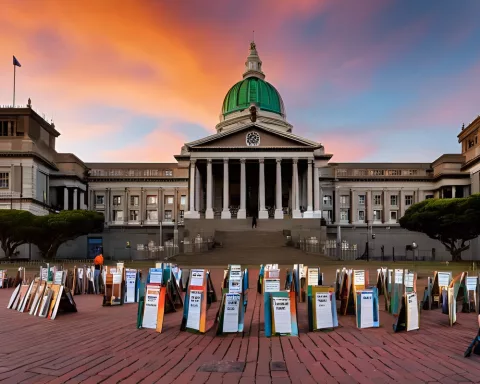The protest outside Leeuwenhof was a loud and passionate plea for justice, focused on the urgent need for social housing in the Western Cape. Hundreds of determined voices gathered in the early morning chill, demanding action from Premier Alan Winde to address a housing crisis that affects over 600,000 people. With banners and songs echoing the struggle against inequality, they sought to reclaim their dignity and rights. The protest wasn’t just about homes; it was a powerful stand against the unfairness that keeps the poor from having a place to live. As they stood together, they sent a clear message: they will not back down until their voices are heard.
What was the protest outside Leeuwenhof about?
The protest outside Leeuwenhof was a unified call for justice, demanding the release of land for social housing and accountability from Premier Alan Winde regarding the housing crisis in the Western Cape. Protesters sought to reclaim dignity and agency in the face of a growing housing backlog exceeding 600,000 needs.
Rising Voices in the Cold Dawn
Early on a brisk Monday morning, the stately residence of Western Cape Premier Alan Winde became the unexpected stage for a fervent display of defiance and solidarity. As the chill of the pre-dawn hours enveloped the city, hundreds of protesters gathered outside Leeuwenhof, undeterred by the impending heavy rain. Their unified cry for justice resonated through the air, as they held banners and posters proclaiming, “I am an occupier, stop evictions,” and “End white property power.”
Despite the palpable tension, the protesters found their resolve strengthened. The echoes of history seemed to accompany their struggle songs, reminiscent of South Africa’s long-standing fight against oppression and inequity. Their demands were clear and pressing: the release of provincially-owned parking sites and the Tafelberg site in Sea Point for social housing, alongside transparency in the 353 Main Road public participation process.
Leaders at the Forefront
Buhle Booi, a leading figure from the organization Ndifuna Ukwazi, stood prominently at the forefront of this movement. His voice carried the weight of numerous stories of displacement and broken promises. “We’ve asked him to come and engage with the residents on the housing crisis. He put conditions on the engagements,” Booi articulated, cutting through the morning fog with his call for action. The housing backlog in the Western Cape had ballooned to over 600,000 unmet needs, a staggering figure that underscored the urgency of their cause.
Premier Winde, in a poignant letter to Reclaim the City, set a firm tone, stating, “I am also not willing to meet with you until you condemn the ongoing illegal occupation of the Helen Bowden Nurses Home and other properties which have been earmarked for affordable housing in central Cape Town and make every effort not to further hamper our efforts to develop these sites for our most vulnerable residents.” His words, though intended to justify his stance, only further galvanized the protesters. The disconnect between the government’s rhetoric of development and the lived reality of the occupiers was stark.
Booi’s response was unequivocal: “We are left with no choice but to come and bring the meeting to him because he doesn’t want to engage with us. We need answers.” His raw determination mirrored the collective sentiment of the gathered crowd. For them, occupation was not merely a tactic but a necessary response to a failed housing system. Karen Hendricks, another vocal leader from Reclaim the City, emphasized, “We know he doesn’t want to engage with us. It was a decision that we took that if he’s not coming, then we are coming to him and holding him to account.”
Persistent Voices and Growing Tensions
As the sky began to lighten, the crowd’s numbers and tenacity only grew. Mzwethemba Sofika, an activist from Mfuleni, voiced a shared resolve, stating, “We are not going to sleep. Wherever he is going to, we will be there until he gives us the answers.” This persistence reflected a community long ignored and desperate for change.
As dawn approached, the police presence became more formidable, their attempts to clear the entrance met with steadfast resistance. Premier Winde, however, remained distant, both physically and metaphorically, from the impassioned pleas outside his residence. His office refrained from offering any comment on the unfolding protest.
This act of civil disobedience did not go without criticism. On the preceding Sunday, Tertuis Simmers, the MEC of Infrastructure, lambasted the activist groups. Simmers painted a starkly different picture of the housing crisis: “It is concerning that these activist groups that claim to fight for spatial redress and the poor are seemingly working against our efforts to deliver viable housing opportunities, especially in the City of Cape Town.” He pointed to the economic strain imposed by unlawful occupations and land invasions, which had cost the Western Cape Department of Infrastructure nearly R987 million since 2019. This financial burden, he argued, diverted resources from deserving beneficiaries.
The Broader Struggle and Global Resonance
Premier Winde accused certain activist groups of misleading the public on housing issues. “This does not help matters and only serves to divide us when we should be working together to find multiple solutions and approaches to meet our housing needs,” he asserted. His call for unity, however, stood in stark contrast to the actions and conditions set by his office.
What unfolded outside Leeuwenhof was more than just a protest. It was a narrative of resistance, deeply rooted in the historical struggles against spatial injustice and economic disparity. The protesters’ chants and songs were reminiscent of the defiance that once echoed in the streets of Soweto and Sharpeville, where the fight for dignity and equity played out against the backdrop of systemic oppression.
The modern-day struggle for housing in Cape Town serves as a microcosm of South Africa’s broader challenges. The juxtaposition of wealthy enclaves and impoverished townships underscores a persistent legacy of apartheid-era spatial planning. Activists like Booi and Hendricks represent a new generation of leaders, carrying forward the torch of social justice with a focus on housing—a fundamental human right that remains elusive for many.
As the protests continued into the day, it became clear that the demand for affordable housing was not merely about bricks and mortar. It was about reclaiming agency and dignity for the marginalized. It was about challenging the power dynamics that have long favored the affluent at the expense of the poor. The protesters outside Leeuwenhof were not just seeking shelter; they were demanding recognition and respect.
In the context of global urbanization and housing crises, the scene at Leeuwenhof resonates far beyond the borders of Cape Town. Cities like New York, London, and Mumbai grapple with similar issues of gentrification and displacement. The struggle for affordable housing is a universal one, reflecting broader socio-economic divides and the urgent need for inclusive urban policies.
As the day wore on, the protesters’ resolve did not wane. They remained a steadfast reminder that the fight for housing is far from over. Their presence outside the Premier’s residence symbolized a broader call for accountability and action—a call that echoes across the globe, wherever inequity persists.
FAQ: A Stand for Justice Outside Leeuwenhof
What was the protest outside Leeuwenhof about?
The protest outside Leeuwenhof was a unified call for justice, focusing on the urgent need for social housing in the Western Cape. Hundreds of protesters gathered to demand accountability from Premier Alan Winde regarding the housing crisis that affects over 600,000 people in the region.
Who were the key figures leading the protest?
Buhle Booi from Ndifuna Ukwazi and Karen Hendricks from Reclaim the City were prominent leaders at the protest. They articulated the community’s grievances, emphasizing the need for government engagement and accountability regarding the housing crisis.
What specific demands were made during the protest?
Protesters demanded the release of land, including provincially-owned parking sites and the Tafelberg site in Sea Point, for social housing development. They also called for transparency in the public participation process related to housing development at 353 Main Road.
How did the government respond to the protest?
Premier Winde’s office issued a letter indicating a refusal to engage with protesters until they condemned illegal occupations of properties designated for affordable housing. This stance further fueled tensions between the government and activists, highlighting a disconnect between government rhetoric and the realities faced by the community.
What are the broader implications of this protest?
The protest reflects a wider struggle against systemic inequality and the ongoing housing crisis not only in Cape Town but also in cities around the world. It underscores the need for inclusive urban policies that prioritize affordable housing as a fundamental human right.
How can the public get involved or support the cause?
Individuals can support the cause by raising awareness about the housing crisis, participating in community discussions and events, engaging with local advocacy groups, and pushing for policy changes that promote social and economic justice in housing.












